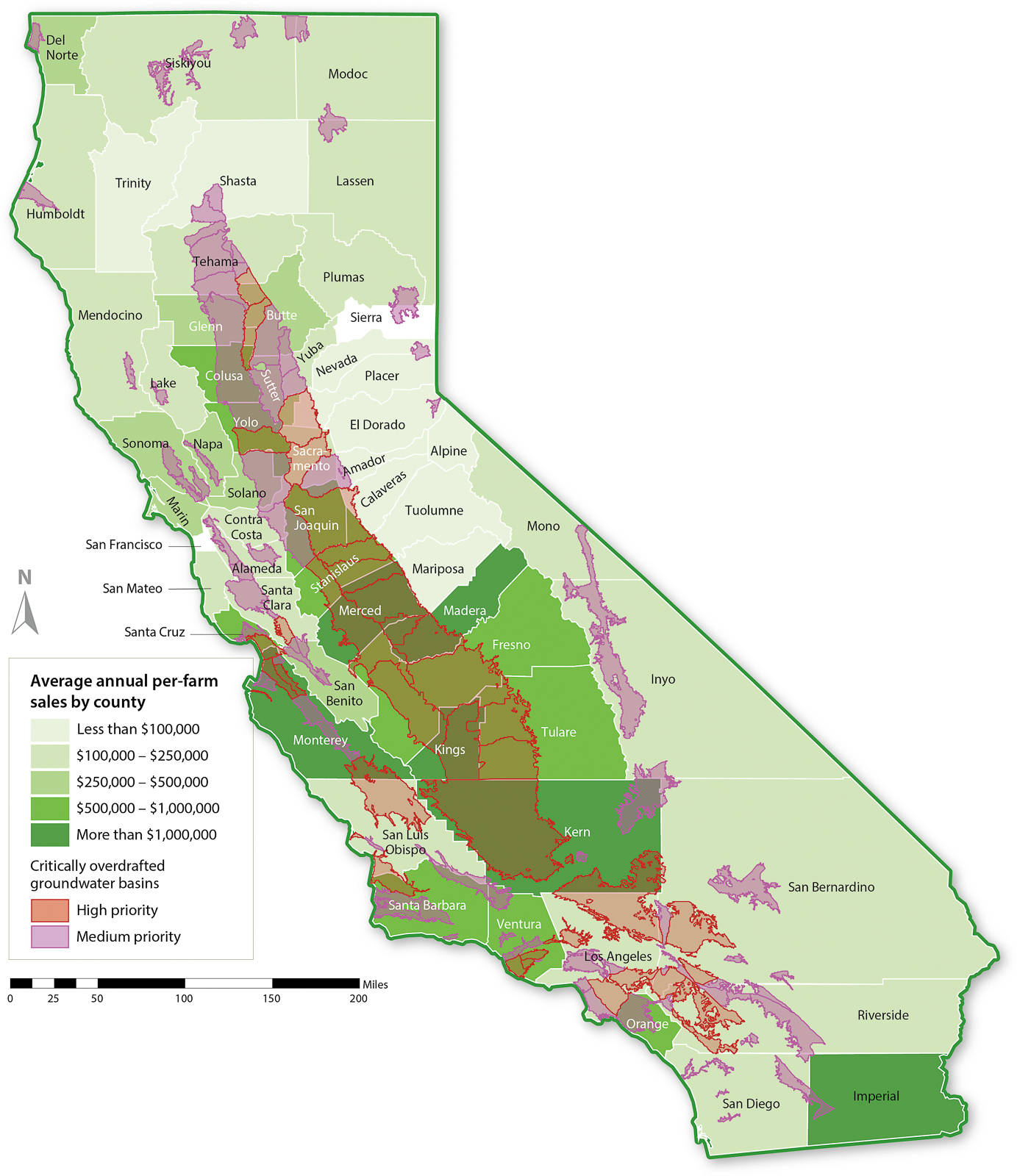All Issues
The Sustainable Groundwater Management Act challenges the diversity of California farms
Publication Information
California Agriculture 70(4):169-173. https://doi.org/10.3733/ca.2016a0015
Published online November 16, 2016
NALT Keywords
Full text
California's agricultural sector, a major groundwater user, finds itself in the midst of the implementation of the Sustainable Groundwater Management Act (SGMA).
The law mandates the formation of local groundwater sustainability agencies (GSAs) and adoption of groundwater sustainability plans (GSPs) for all overdrafted groundwater basins across the state by 2020. Each GSA will be unique, with its own governance structures and rules, including the size and composition of the governing board, mechanisms for representing different interests, opportunities for stakeholders to participate, and rules concerning the allocation of pumping “rights” and the use of economic instruments, such as pumping permits, pumping taxes or tiered pricing, to incentivize pumping curtailments (DWR 2016).
This new water management landscape may threaten the diversity of the state's farming operations
Farm diversity — in size, as a proxy for resources and capacity — has been shown to foster innovation, increase stability and resilience under changing climate conditions, and facilitate building knowledge and human capital to support future generations of farmers (Brummer 1998; Davidson 2016; Ericksen et al. 2009; Foley 2011).
Farms of all scales will be required to comply with SGMA and the management plans established by their local GSAs; however, farms of different scales have varying human and financial resources. As such, compliance with SGMA requirements is likely to be manageable for some growers but severely burdensome for others. Unless GSAs explicitly address this equity concern and consider all growers’ water needs during the planning and implementation phases of SGMA, the law will threaten the future of the state's agricultural diversity.
Farm scale and SGMA
In April, the authors and other graduate students in the National Science Foundation Climate Change, Water and Society Integrated Graduate Education Research Traineeship Program hosted a conference — “Weathering Change” — at UC Davis to discuss the implications of SGMA for California. One panel featured three growers — Don Cameron, Russ Lester and Emma Torbert — who illustrate the breadth of farm scales across the state (figs. 1 and 2). Here, we summarize the perspectives they shared and explore the challenges they have already begun to experience in relation to the equitable implementation of SGMA, including: (i) producing and accessing pertinent surface-groundwater information, (ii) financing new infrastructure and (iii) representing varied water users and resource needs.
Don Cameron
General manager of 6,000-acre Terranova Ranch Inc. and chair of the state's Environmental Farming Act Science Advisory Panel, Don Cameron grows 26 crops near Fresno. Terranova Ranch receives some Kings river water through a mutual water company, but relies on groundwater for more than 95% of its irrigation, using 45 metered wells that are pumping from approximately 600 feet deep. Cameron has been a leader in water conservation for decades: he was an early adopter of drip irrigation technologies in the 1980s and is currently partnering with UC Agriculture and Natural Resources to experiment with groundwater recharge practices, including on-farm flood capture.
Cameron has been extensively involved in local SGMA planning, sometimes attending three GSA meetings a week. Even though this participation has placed significant strain on human resources, Cameron explained that having a voice in SGMA implementation is not only a responsibility for growers like himself, but a priority. He appreciates that smaller farmers are not able to spend the same time away from their fields, and explained that his region has attempted to build representation of agriculture and rural communities’ diverse interests into their GSA boards. He said that he is optimistic that SGMA's mandate for development of new institutions and plans for reducing groundwater overdraft will initiate needed changes to protect groundwater resources well into the future, but acknowledges the challenges that lie ahead, particularly with respect to implementing and enforcing pumping restrictions.
Russ Lester
Owner of 1,400-acre Dixon Ridge Farms in Solano County, Russ Lester grows organic walnuts, processing tomatoes, wheat and edible dry beans, and also operates one of the largest organic walnut processing and marketing operations in the state. Like many farmers in the Central Valley, he is shifting from annual to perennial crops, and is currently experimenting with wine grapes, almonds, olives and prune trees, which has hardened his water demand. Dixon Ridge Farms has riparian rights to surface water from local creeks, but approximately 90% of operations rely solely on groundwater. Lester is concerned that groundwater levels in his region are in jeopardy, experiencing well-level drops on his own properties in recent years. As a result, he has invested in deeper wells and installed monitoring meters on all new pumps.
Lester has been an active leader in speaking for the basin's heterogeneous agricultural interests (i.e., many crops, different water sources, variable groundwater conditions across the large basin) and is organizing some of the small to mid-sized growers in his region to work together to ensure that they have a collective voice in the Yolo and Solano county GSAs, particularly in determining how pumping restriction rules will be designed and enforced. He also stressed the need for assistance in developing good information on surface-groundwater interactions.
Emma Torbert
Co-manager of The Cloverleaf Farm, Emma Torbert grows 4 acres of organic fruit trees and mixed vegetables near Davis. Cloverleaf Farm has no surface water access and relies on a single 200-foot well for irrigation. Over the past 5 years, Torbert has experimented with reduced irrigation schedules in her orchard, cutting back water use by nearly 50%. She has also made infrastructure improvements, installing soil moisture probes, solar panels on well pumps, gray-water washing systems and landscaping fabric, with assistance from the State Water Efficiency and Enhancement Program (SWEEP).
Torbert is a leader in Yolo County's Farmer's Guild, the local branch of a statewide organization that brings small growers together to share sustainable best management practices and pool efforts to address shared challenges. She represents an early-career, small, organic grower, and reiterated many of Cameron and Lester's comments on the high economic and opportunity costs of participating directly in SGMA processes. She shared that she cannot afford to dedicate time away from her farm to participate in local GSA-planning discussions. She is hopeful that groups like the Farmer's Guild or California Certified Organic Farmers (CCOF) will coordinate small growers across the state to efficiently share the costs of participation and advocate for adequate representation of their groundwater needs throughout SGMA planning phases.
Challenges
Cameron, Lester and Torbert represent just a few of the many perspectives within the agricultural community, but they highlight important differences that will be felt across the state as operations of different sizes move forward with SGMA compliance. We focus here on concerns related to information dissemination, new expenses and political representation.
Producing and accessing information. Cameron, Lester and Torbert all emphasized the need for improved information.
One common desire is for a better understanding of how local surface and groundwater resources interact. Despite extensive monitoring efforts by the California Department of Water Resources throughout the state's 515 groundwater basins, groundwater flux and reserve information is not readily available to growers, particularly in basins that have been given a low priority designation. SGMA requires understanding these basins’ withdrawals and reserves, and thus will likely require the development of a new fine-scale monitoring system, which may include well monitors on all public and private pumps.
Torbert expressed wanting specific instruction on when and how to participate in local SGMA decision-making processes. We hypothesize this is a common feeling shared among many small to mid-sized or politically unseasoned growers who have little to no experience participating in governance processes or defining resource management rules.
Bridging organizations that work in spaces between research, policy and implementation sectors often play an essential role in coordinating and sharing this type of information (Cash 2011). We suggest that UC Cooperative Extension, the Natural Resources Conservation Service, and resource conservation districts, and active agricultural and environmental nongovernmental organizations, fill this role, and by doing so, could assist in equalizing knowledge among growers, so that those less politically active are sufficiently informed to be able to participate if they choose. In fact, SGMA may provide a kick-start to improved communication both between individual growers and across institutions working within the agricultural sector to share knowledge and collaborate across scales around adapting to changing climate conditions.
New expenses. Farms of all scales will be required to meet similar groundwater sustainability goals. Compliance may result in increased pumping operational and capital costs (e.g., new or updated pumping infrastructure, monitoring and reporting, compliance fees, training and education). In addition, caps on pumping may drive the emergence of markets for trading pumping allowances among farms. While such trading should result in more efficient use of groundwater overall, it will increase costs for growers that need to buy pumping allowances.
These increased costs are expected to have greater relative impact on smaller growers. To mitigate these burdens, Cameron advocates for the state to assist in funding the systemic infrastructure and monitoring adaptations that are likely to be mandated by SGMA. Torbert pointed to opportunities to crowd-source funds through community engagement with local customers who like to support small-scale growers. Cost-sharing programs will be particularly important for small and mid-sized growers with less budget flexibility and limited ability to participate in state-funded conservation programs. These growers, particularly early-career farmers, face high entrance barriers to access land and equipment and are vulnerable to acquisition by larger operations, conditions that could be exacerbated by new economic challenges. In actuality, accessing funds to assist in SGMA compliance efforts is a palpable challenge that will generate debates amongst growers and is mostly likely to be addressed uniquely within each GSA (rather than by the state).
Representing varied resource needs. Small and mid-sized farms tend to face steeper barriers in terms of opportunity costs for staff to participate in policy planning forums. Thus, we can anticipate that farms with greater stocks of human, social and financial resources will be better prepared to play a prominent role in building new institutions and crafting collective rules of management practice within each GSA (Lubell 2002).
It is also important to note that participation in the GSA formation process does not necessarily translate into representation per se; attending a meeting does not guarantee voting rights or that one's priorities are discussed. Furthermore, differing access and control over resources influence stakeholders’ positions in multi-stakeholder meetings and their capacity to actively engage in the decision-making process and influence group decisions (Bachrach et al. 1962; Lubell 2002; Swyngedouw 2015). As a result, power asymmetries among diverse stakeholders play an important role in the emergence of institutions like GSAs. The design of governance structures and the forms they take (e.g., allocation of pumping rights, rules of management practice) in turn shape institutional outcomes — including whose interests are considered and prioritized during GSP development and the nature and extent of groundwater management regulations on farms. Certain parts of the state with higher farm diversity (fig. 2) will need to accommodate wider ranges of needs in their GSPs, which we hypothesize will challenge balancing equitable participation, representation and distribution of resources. This suggests a strong need for small farmer communities to formally collaborate to have their voices heard at SGMA institutional processes.
Fig. 1. The average farm sales* by county are overlaid with the high and medium priority critically overdrafted groundwater basins** that must comply with SGMA by 2020. As apparent, counties with high value crops and large agricultural interests often correspond with high priority basins. Given the high concentrations of economic and political power in these basins, we predict that achieving equitable GSA representation will be more challenging in these basins than in basins of lower agricultural economic value. * Farm sales categories based on those defined in USDA Census 2012; ** DWR CASGEM basin boundary prioritization.
Fig. 2. A Shannon-Wiener diversity index for farm size was calculated for each county and is overlaid with high and medium priority critically overdrafted groundwater basins*. The diversity index is calculated based on the number of farm size categories** present in each county and the distribution of individual farms within each size category, where greater diversity scores correspond to more even distributions of farms of different sizes. We predict that equitable representation of agricultural interests in GSAs will be even more difficult in basins with greater farm diversity. Pre-existing agencies could aid in this process by providing established leaders, management plans, or monitoring systems, but the legacy of organized water management controlled by these agencies may further challenge representation of new and diverse agricultural water users. * DWR CASGEM basin boundary prioritization; **Farm size categories based on those defined in USDA Census 2012.
Conclusions
Given the heterogeneity of farms in California, we can anticipate that SGMA's demands for participation and its derived institutional outcomes will have varied effects on farming communities. In addition, understanding the potential struggles of small farmers provides insight into similar challenges faced by other stakeholders likely to be underrepresented in the GSA formation process, including disadvantaged communities.
SGMA has institutionalized a major reevaluation of agricultural water use and applies necessary timely pressure to design basin-wide sustainability plans before groundwater resources are irreversibly overexploited. However, government officials from the Department of Water Resources and the State Water Resources Control Board who are facilitating the design and implementation of SGMA must sufficiently understand and anticipate stakeholder needs to ensure that new governing institutions and management plans are not fraught with delays and conflict.










